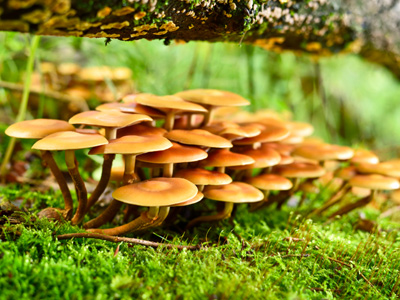
Ask the AI Tutor
Need help with Health 02? Ask our AI Tutor!
AI Tutor - Lucy
Connecting with Tutor...
Please wait while we establish connection

These mushrooms are fungi. They are simple plants but they do not contain chloroplasts. Fungi cannot photosynthesise.
Health 02
Health in KS3 Science explores how diet and lifestyle choices affect the body, including the importance of balance, variety, and moderation in what we eat and drink.
1 .
Which microbe can be killed by antibiotics?
Bacteria
Fungus
Mould
Virus
Antibiotics only work on bacteria, they do not destroy viruses or fungal infections
2 .
Which microbe invades cells?
Bacteria
Fungus
Mould
Virus
Viruses can reproduce rapidly, but only in living cells. A virus is technically not alive, it shows none of the signs of life like respiration. It is more like a chemical that can reproduce itself when it gets into a living cell. To talk about killing a virus is not really correct, it is better to say destroying a virus
3 .
Which of the following is NOT caused by a virus?
Cold
Flu
HIV
Tetanus
Spores of the tetanus bacteria enter a wound from soil, dust or animal faeces. You can't catch tetanus from someone who has the disease
4 .
Which type of cell can produce antibodies?
Blood plasma
Muscle cells
Red blood cells
White blood cells
These defend your body against infection by bacteria, viruses and fungi
5 .
Which of the following is caused by a fungus?
Athletes foot
Chickenpox
Measles
Tennis elbow
People with athletes foot should not use communal showers as it is easy to pass it on to others. It is easily cured by using an anti-fungal cream or powder
6 .
Fungi are simple plants but they do not contain .......
A nucleus
A vacuole
Cell walls
Chloroplasts
Fungi can't photosynthesise, they obtain their nutrients by releasing enzymes onto the material around where they are growing
7 .
Which of the following is least likely to introduce living bacteria into our bodies?
A cut on our knee
A vaccine
Breathing
Eating and drinking
Some vaccines have living bacteria but in a weakened form. A vaccine trains our white blood cells what antibodies are needed to fight off the infection in the future
8 .
The range of antibodies in your blood can be safely increased by ...
breathing
drinking
eating
vaccination
This helps to create immunity to certain diseases that were once responsible for killing millions of people
9 .
In which of the following foods are microbes NOT used?
Bread
Flapjacks
Wine
Yoghurt
There are more microbes on your body than there are humans on Earth
10 .
Which of the following does NOT involve fungi?
Beer
Bread
Meat
Mushrooms
Mushrooms are fungi. Bread and beer are made with yeast which is a fungus
**Unlimited Quizzes Await You! 🚀**
Hey there, quiz champ! 🌟 You've already tackled today's free questions.
Ready for more?
Ready for more?
🔓 Unlock UNLIMITED Quizzes and challenge yourself every day. But that's
not all...
not all...
🔥 As a Subscriber you can join our thrilling "Daily Streak" against other
quizzers. Try to win a coveted spot on our Hall of Fame Page.
quizzers. Try to win a coveted spot on our Hall of Fame Page.
Don't miss out! Join us now and keep the fun rolling. 🎉
**Unlimited Quizzes Await You! 🚀**
Hey there, quiz champ! 🌟 You've already tackled today's free questions. Ready for more?
🔓 Unlock UNLIMITED Quizzes and challenge yourself every day. But that's not all...
🔥 As a Subscriber you can join our thrilling "Daily Streak" against other quizzers. Try to win a coveted spot on our Hall of Fame Page.
Don't miss out! Join us now and keep the fun rolling. 🎉






